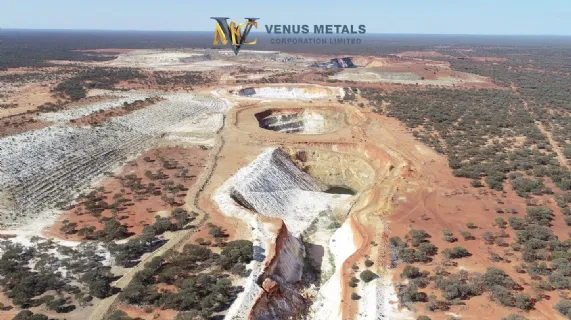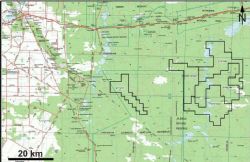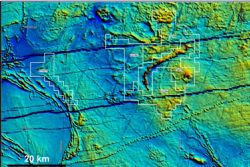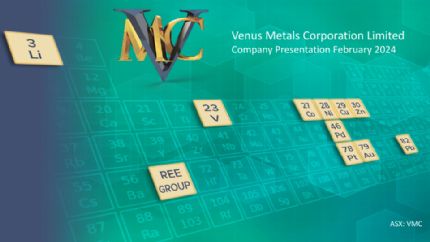
Marvel Loch East Widespread REE Mineralisation Confirmed
Perth, Jan 16, 2023 AEST (ABN Newswire) - Venus Metals Corporation Limited ( ASX:VMC) is pleased to announce the preliminary results of recent field work and geochemical sampling programs on its tenement E15/1796 located ~60 km east of Marvel Loch (Figure 1*).
ASX:VMC) is pleased to announce the preliminary results of recent field work and geochemical sampling programs on its tenement E15/1796 located ~60 km east of Marvel Loch (Figure 1*).
HIGHLIGHTS:
- Significant rare earth elements (REEs) enrichment confirmed in monzogranite bedrock with recent results in rock chips up to 4,365 ppm TREO (Figure 2*).
- A grab sample of drill spoil from historical drill hole 02BOVR002 in E15/1796 has TREO of >3,000 ppm in clay (Figure 2*).
- Petrographic studies of monzogranite bedrock identify weathering and release of REEs from primary REE host (allanite) in surface samples, which is favourable for the formation of REE-enriched clays.
WORK PLANNED AND/OR IN PROGRESS:
- Detailed aeromagnetic and radiometric survey in progress to delineate prospective magnetic highs within the ~25 km-long magnetic trend for further testing and drill target prioritisation.
- Metallurgical test work in progress to investigate the potential for cost-effective beneficiation of the monzogranite bedrock REE mineralisation using comminution and magnetic separation techniques.
- Diagnostic metallurgical tests (pH 4) in progress at ANSTO and ALS on 10 clay samples from historical drill spoil samples.
- Shallow AC drilling planned to target residual clay zones developed on REE-rich bedrock to test for clay-hosted REE mineralisation.
- RC drilling scheduled for early 2023 to test the primary REE mineralisation in the monzogranite bedrock at depth and beneath magnetic highs.
Project background
Venus' Marvel Loch East Rare Earth Project is comprised of one granted exploration licence (E15/1796) and four applications (ELAs 15/1944, 15/1946, 15/1947 and 77/2721) for a total area of 283 blocks (828 km2) (Figure 1*).
As part of an initial regional reconnaissance exploration program, Venus completed systematic soil, rock-chip and laterite sampling on E15/1796 (refer ASX release 30 Sept 2022). The program identified REE anomalies in soil, laterite, and rock chips along the ~25 km strike length of the arcuate magnetic high in the west and across an oval shaped magnetic feature (~3 x 4 km) in the east of E15/1796.
Maxima for TREO in soil and laterite (ferruginous gravel) are 6,092 ppm and 700 ppm, respectively, in the ultrafine fraction (refer ASX release 30 Sept 2022).
The arcuate and ovoid magnetic highs within granite terrain of E15/1796 are suggestive of a regional-scale magnetite-bearing monzogranite that appears to be enriched in REE; a detailed petrographic study of bedrock specimens from outcropping monzogranite is in progress.
Current work
A total of 38 rock chip samples, and 93 samples of historical drill spoil were collected (Figure 1*). Recent rock chip samples from outcropping monzogranite have yielded maximum TREO concentrations of 4,365 ppm in the eastern target area and of 2,292 ppm in the western target area of E 15/1796. These results are ~10 to 20 times the average crustal abundance for TREO (Taylor & McLennan, 1995), suggestive of a bedrock that is highly anomalous in REE. Further, the magnetic rare earth oxide (MREO) percentage of rock chips above 1,000 ppm averages 23% MREO with individual samples ranging as high as 28%.
It is likely that the magnetic anomaly is related to the monzogranite, which outcrops in several places across the tenement with some whalebacks >1 km in diameter (Figure 3a*). Within the arcuate and ovoid magnetic highs (Figure 2*), monzogranite contains abundant magnetite and frequently displays brownish-black spots (Figure 3b-c*) indicative of REE mineralisation.
Initial microscopic studies using scanning electron microscopy (SEM) and optical microscopy have been completed by RSC who are also providing technical assistance at the Company's Mangaroon REE Project (see ASX release 5 September 2022). Five thin sections of the monzogranite and two resin blocks of a magnetic concentrate were prepared. The samples were analysed using automated mineralogy (AMICS), energy-dispersive spectroscopy (EDS) elemental maps and spot analyses, and backscatter electron (BSE) images (Figure 4*).
The monzogranite is dominated by albite, k-feldspar, quartz, biotite, magnetite +/- titanite, rutile, zircon, chlorite, apatite and Ca-Fe amphibole. The primary magmatic REE mineral throughout the monzogranite is allanite (Ce,Ca,Y,La)2(Al,Fe+3)3(SiO4)3(OH) along with minor REE-bearing titanite and apatite. Allanite occurs in association with biotite and magnetite (Figure 4a, d-e*) and is responsible for the brownish-black spots displayed in Figures 3b-c*.
Monzogranite collected on the surface reveals the breakdown of allanite to secondary REE phases and Fe-oxides (Figure 4a, d-e*) and titanite to Ti(+Fe, Mn) oxides due to weathering. Secondary REE phases,
including REE oxides, Ca-REE fluorocarbonates, and ferriallanite form as replacement products on the rim of allanite as well as in veinlets dispersed in the monzogranite (Figure 4e). Secondary REE phases have a higher REE concentration due to lower concentrations of Al and Si relative to allanite (Figure 4c*)
These results indicate that REEs are released from the source rock during weathering and are not entrapped in resistate phosphates such as monazite - all of which is favourable for the formation of REE clays.
The bedrock enriched in primary and secondary rare earth mineral phases presents a source for residual enrichment within the regolith during weathering, a process that may have led to the formation of clay-hosted REE mineralisation. As part of the weathering of the fresh monzogranite,
allanite and secondary rare earth mineral phases or alteration minerals can dissolve and concentrate in the weathering zone to form clay-hosted secondary rare earth mineralisation. A grab sample of drill spoil from historical RAB hole 02BOVR002 (WAMEX Report A70400) shows a maximum TREO concentration of 3,356 ppm in in clay from ~20m depth. The average MREO percentage for drill spoil samples above 1,000 ppm is 23.2 % (Table 1*) with up to 33% for the described high-grade sample.
Venus also considers the REE-enriched bedrock to be a potential REE source in its own right if a REE enriched concentrate can be separated. It is likely that fresh unaltered allanite is encountered below the weathered surface. Venus has commissioned preliminary metallurgical test work to quantify the enrichment of REE associated with specific mineral phases to exploit a potentially vast monzogranite bedrock resource; analytical results for nine magnetic and non-magnetic subsamples are pending.
In this context, it should be noted that an Australian company, American Rare Earths ( ASX:ARR) recently reported results of mineralogical and metallurgical test work on its Halleck Creek REE project in Wyoming, USA. Mineralogy tests indicate that the rare earth host mineral allanite can be easily liberated and that the "simplicity of allanite liberation allows for higher recovery and ability to upgrade rare earth elements at lower costs" (refer ARR ASX release 2 Dec 2022).
ASX:ARR) recently reported results of mineralogical and metallurgical test work on its Halleck Creek REE project in Wyoming, USA. Mineralogy tests indicate that the rare earth host mineral allanite can be easily liberated and that the "simplicity of allanite liberation allows for higher recovery and ability to upgrade rare earth elements at lower costs" (refer ARR ASX release 2 Dec 2022).
An aeromagnetic and radiometric survey across the regional magnetic highs has been partly completed and processing is underway; these data will form the basis for further field investigations and drill targeting.
Future Work
Venus is planning shallow AC drilling to test areas of deep weathering and preserved regolith for clayhosted REE mineralisation. RC drilling is planned to test the monzogranite for potential enriched zones of bedrock-hosted REE mineralisation possibly associated with stronger magnetic responses based on the results of the current aeromagnetic survey.
Following the discovery of secondary rare earth mineral phases in the fresh rock that may form clayhosted rare earth mineralisation during weathering, clay samples were taken from historical drill spoil across the northern part of the arcuate magnetic high. These samples that represent the weathering zone have been submitted to ANSTO and ALS for diagnostic metallurgical tests (pH 4).
RSC will continue with the petrographic and SEM work and this will deliver a better understanding of the mineral paragenesis, the deportment of REE in the monzogranite, identification of REE mineral phases, mineral liberation, among other factors. These results will also help to understand the genesis of the Marvel Loch East REE mineralisation and assist with establishing mineral processing techniques.
*To view tables and figures, please visit:
https://abnnewswire.net/lnk/04J0N3EM
About Venus Metals Corporation Limited
Venus Metals Corporation Limited (ASX:VMC) is a West Australian based Company with a focus on gold, base metals, vanadium and lithium exploration projects. The Company aims to increase shareholder value through targeted exploration success on its projects.
The Company's major gold project is the Youanmi Gold Mine, located 500km north-east of Perth. The Youanmi Gold Mine is now jointly owned by Venus Metals (30%) and Rox Resources Limited (70%); Indicated and Inferred Resource of the mine is in excess of 3 million ounces of gold.
| ||
|












